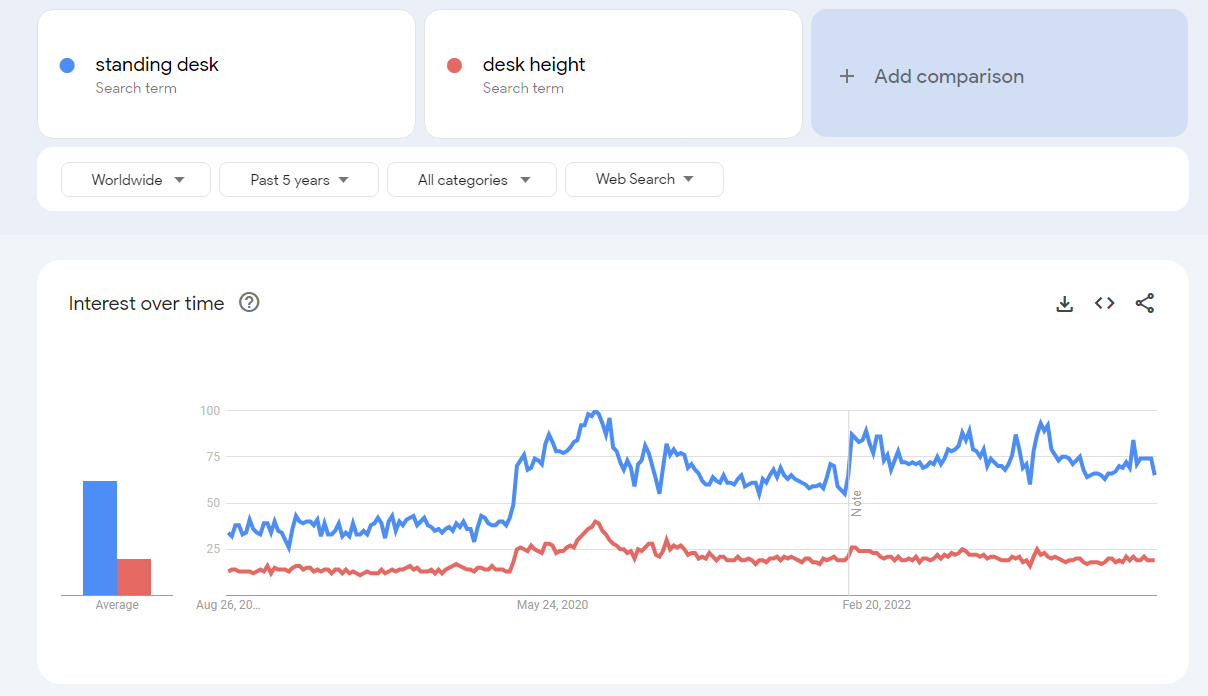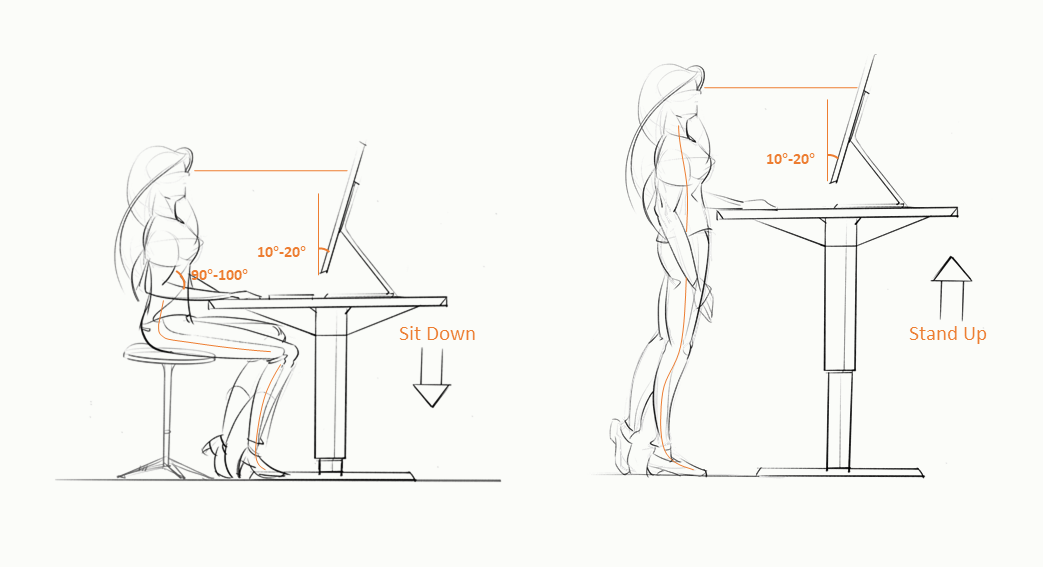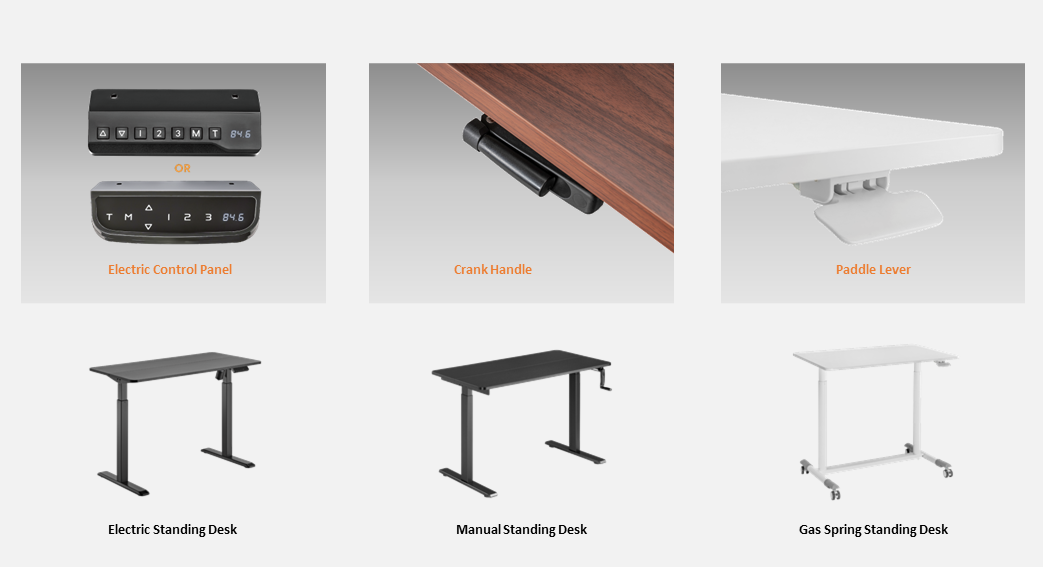Finding the Ideal Fit: How High Should a Standing Desk Be?
In recent years, the popularity of standing desks has skyrocketed, as people have become more aware of the detrimental effects of sitting for prolonged periods. A standing desk allows one to break away from the traditional seated work environment and offers a range of health benefits. However, as google trends data shown below, one crucial point that often gets overlooked is the height of sit-stand desks. In this comprehensive guide, we will delve into the nuances of standing desk height, discussing what determines the proper height, the myriad benefits of using a standing desk, and how to adjust the desk to achieve optimal ergonomics.
What Determines the Desk Height?
There is no one-size-fits-all solution regarding the height of a standing desk. Many factors can influence the user’s comfort, posture, and well-being. Here are some critical considerations to keep in mind that may help find the right balance.
Body Height
The most important one of the factors in determining a standing desk height is the user’s own height. Too high or too low of a desk both have harmful effects on people’s bodies. Taller individuals will naturally require a higher desk to avoid being phubbers or working with a kyphotic posture. Conversely, shorter individuals might need a lower desk to prevent strain on their shoulders and neck. The chart below helps to calculate the proper standing desk height based on people’s size.
| Your Height | Sitting Desk Height | Standing Desk Height |
| 5'0" | 22.5" | 36.5" |
| 5'1" | 23" | 37" |
| 5'2" | 23" | 37.5" |
| 5'3" | 23.5" | 38" |
| 5'4" | 24" | 39" |
| 5'5" | 24.5” | 39.5" |
| 5'6" | 25" | 40.5" |
| 5'7" | 25" | 41" |
| 5'8" | 25.5" | 41.5" |
| 5'9" | 26" | 42.5" |
| 5'10" | 26.5" | 43" |
| 5'11" | 27" | 43.5" |
| 6'0" | 27" | 44" |
| 6'1" | 27.5" | 44.5" |
| 6'2" | 28" | 44.5" |
| 6'3" | 28.5" | 46" |
| 6'4" | 28.5" | 47" |
| 6'5" | 29" | 47.5" |
| 6'6" | 29" | 48" |
| 6'7" | 29.5" | 49" |
| 6'8" | 30" | 49.5" |
Elbow Angle
The angle at which elbows are positioned while typing is crucial for preventing discomfort and strain. Ideally, the elbows should be at a 90°-100° angle when typing. Additionally, users should adjust the height of desks to ensure the forearms and wrists are straight when the hands rest on the keyboard.
Screen Position
Keep the top third of the monitor or laptop screen at eye level to avoid craning the neck downward or upward. This not only prevents neck strain but also promotes a good posture. One great suggestion says that a monitor arm or laptop riser may help to achieve an ergonomic viewing position easily.
Foot Wear
While one’s upper body's ergonomics are essential, don't forget about the feet. What the feet wear also plays a vital role in determining the desk height. To ensure that the feet are comfortably resting on the floor or a footrest, the height of the desk should be adjusted accordingly to accommodate different shoe heights. For example, if someone frequently wears heels, the desk may need to be slightly higher to maintain proper ergonomics. On the other hand, if someone prefers to work barefoot or in flat shoes, a lower desk height may be more suitable.
All in all, the optimal desk height should encourage a natural, eased, and upright sitting or standing posture, keep shoulders, neck, legs, and feet relaxed, and maintain the spine in a neutral position. The height-adjustable desks can satisfy different preferences and promote a good posture for a more comfortable and healthier work style.
Why Use a Standing Desk?
Studies have shown that excessive sitting increases the risk of developing chronic health problems. Many ergonomics experts agree that switching between standing and sitting has positive effects that go beyond obvious physical comfort. So sit-stand desks would be a great choice to start an ergonomic work style.
Regular breaks from sitting can help reduce the risks associated with sedentary behavior, such as obesity, high blood pressure, heart disease, and diabetes. Incorporating standing or light activity into the daily routine can also improve posture, increase energy levels, and enhance productivity. Try out a standing desk, and the benefits gained would be out of the expectation.
| Personal Benefits |  |
Business Benefits |
| ü Improve blood circulation | ü Improve productivity and work quality | |
| ü Boost mood and focus | ü Boost efficiency | |
| ü Burn calories | ü Increase employee retention | |
| ü Build a correct posture | ü Enhance job satisfaction and loyalty | |
| ü Relieve back and neck pain | ü Grow corporation image | |
| ü Reduce the risk of high cholesterol | ü CSR (Corporation Social Responsibility) | |
| ü Reduce the risk of obesity | ü Reduce wasted time at work | |
| ü Reduce the risk of long-term mortality | ü Reduce absenteeism | |
| ...... | ...... |
How to Adjust the Standing Desk Height?
After learning about the factors that influence desk height and the benefits of using a standing desk, let's explore how to adjust the desk to achieve optimal ergonomics. LUMI’s standing desks vary in 3 height adjustment mechanisms to meet different needs. All mechanisms are designed for effortless, smooth, quick, and quiet height adjustments.
Smart Electric control: Available in touch mode and button mode. Designed with memory settings, the electric control is ever-intuitive to operate and fast to reach the desired position with a gentle press or touch. Built-in reminder helps build a good sitting-standing habit.
Effortless Crank Handle: No power is required and the users can adjust the desk to any desired position by turning a handle at will.
Air-Lift Paddle Lever: Powered by gas springs, pneumatic standing desks are easy to move up or down fast and quietly by squeezing a paddle lever.
Conclusion
Finding the optimal height for standing desks requires considering various factors and individual needs. Utilizing a standing desk offers plenty of benefits, from improved posture and energy levels to reduced chronic disease risks. Invest in standing desks! It is not just a trend but a strategic decision that can boost your profits in the promising ergonomics market.





